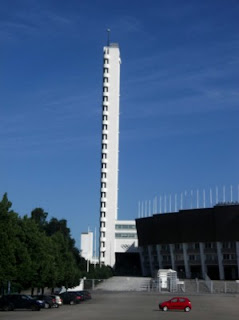 It was Sunday and very festive when The Arcadia anchored at
Warnemunde on the north German coast. Turned out that it was the last day of
the 25th Annual Hanse Rostock Sail. There was a carnival atmosphere and loads
of people were all heading in that direction.
It was Sunday and very festive when The Arcadia anchored at
Warnemunde on the north German coast. Turned out that it was the last day of
the 25th Annual Hanse Rostock Sail. There was a carnival atmosphere and loads
of people were all heading in that direction.
Before we tourists could either go and join in the fun or
relax and watch the boats sailing up and down the river, it was time to go and
tour.
Our guide was excellent, especially at helping us to
understand what life had been like under Communism. Although there were
restrictions such as how much money you were allowed to earn, so long as people
kept their heads below the parapet, life wasn't too bad. Not good but bearable.
And, as the guide pointed out, his parents' generation had suffered under the
Nazi Regime. Now, since reunification things have vastly improved and life is
good.
 The drive to see the Cathedral and town of Bad Dobenan took
us through the flat countryside. Meadows, woods, farmland and pretty thatched
cottages. Sounds very English, doesn't it? But a lot less traffic.
The drive to see the Cathedral and town of Bad Dobenan took
us through the flat countryside. Meadows, woods, farmland and pretty thatched
cottages. Sounds very English, doesn't it? But a lot less traffic.
Bad Dobenan is in the state of Mecklenburg which once had
close ties with Great Britain. One of their Princess's, Charlotte, married a
Hanovarian Prince and they became known as King George III and Queen Charlotte.
Remember the film 'The Madness of King George'?
En route into Rostock we were told that because, during
World War II the Heinkel plane factory had been located there, the town had
been very badly bombed so much of the old town that we were to see had been
rebuilt or renovated. The guide also pointed out some blocks of flats which
were the original Communist blocks but have now been very much renovated. Both
inside and out, with Architectural decorations and good paint jobs. They are
now very much sought after residences.
Back on board the ship and having had lunch I settled on
deck to watch the various regatta ships passing up and down the river.
Everything from many masted yachts to rubber dinghies, some pirate galleons
(one flying the Spanish flag), the steam driven ice-breaker Steltin and police
boats scurrying hither and yon keeping the seaways clear.
If you get a chance to take a Baltic cruise, let me
recommend one with Warnemunde as a port of call. There are several other places
to visit from there including the island of Lubeck, famous for its real Gothic
architecture.















